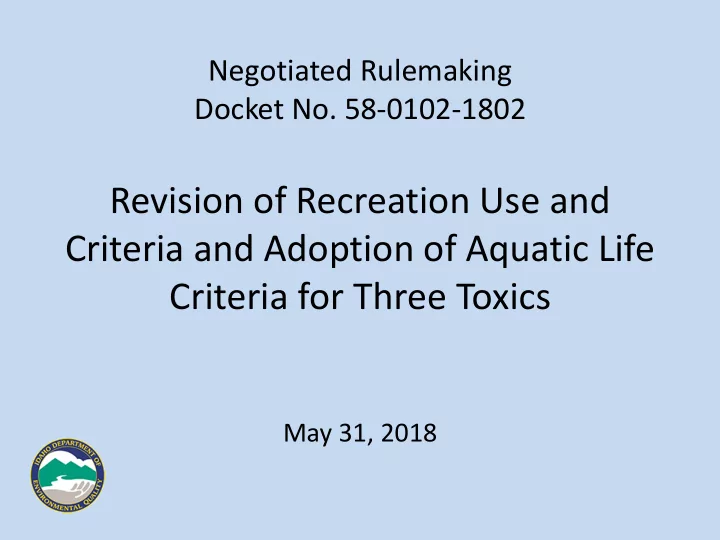

Negotiated Rulemaking Docket No. 58-0102-1802 Revision of Recreation Use and Criteria and Adoption of Aquatic Life Criteria for Three Toxics May 31, 2018
Outline • Recreation Use and Criteria Revision • Adoption of Aquatic Life Criteria for Three Toxics 2
Outline • Recreation Use and Criteria – Why revise? – Current Use Designation • Removing Subcategories – EPA §304(a) criteria • Addition of enterococci criteria • Use of Statistical Threshold Values – Draft Rule Language 3
Recreation Use and Criteria • Why Revise? – Recreation Use subcategories carry same criteria – Consideration of revised EPA §304(a) criteria – Identified as high priority in the 2017 Triennial Review of Idaho Water Quality Standards 4
Recreational Use and Criteria • Recreational use specific criteria: – Bacteria criteria ( E. coli) – Human health criteria • Current Recreational Use Designations (IDAPA 58.01.02.100) – Primary Contact Recreation (PCR) – Secondary Contact Recreation (SCR) – Public Swimming Beach 5
Current Structure • Single Sample Maximum (SSM) for bacteria dependent on use subcategory – thresholds for additional monitoring, NOT criteria E. coli (CFU/100 mL) SCR 576 PCR 406 Public Swimming 235 Beach 6
Recreational Use and Criteria • Multiple use categories, same criteria – Human Health Toxics Criteria : Numeric Criteria for Fish Only exposure (210.01.b) 7
Recreational Use and Criteria • Multiple use categories, same criteria – E. coli criterion: Geometric Mean of 126 CFU/100mL 8
Removing Subcategories • Does not change applicable criteria (or level of protection) • Simplifies monitoring, assessments, TMDLs, and IPDES 9
Criteria Background • Recreational criteria are for fecal indicator bacteria (FIB) • Criteria concentrations are based on rate of gastrointestinal illnesses associated with concentrations of FIB at swimming beaches • For EPA’s 2012 §304(a) criteria recommendation, identified enterococci concentrations related to illnesses, used relationship of enterococci to E. coli to derive criteria 10
Comparison to §304(a) 11
EPA’s 2012 §304(a) Recommendation • Provides 2 sets EPA 2012 Recommended Criteria (cfu/100 mL) of criteria, Illness Rate of Illness Rate of corresponding 36/1000 Users 32/1000 Users to two different Geo STV Geo STV illness rates Mean Mean Indicator E. Coli 126 410 100 320 enterococci 35 130 30 110 12
Enterococci • EPA’s 2012 §304(a) guidance provides enterococci in addition to E. coli • Enterococci directly related to illness rates • New monitoring and analysis techniques may lead to longer sample holding times • Either E. coli or enterococci can be used to demonstrate protection of recreation use 13
Statistical Threshold Value (STV) • EPA’s 1986 recommendation, and Idaho WQS, use SSM derived from the distribution of results associated with illness from previous studies • SSMs were different depending on use intensity • Idaho adopted SSMs as “triggers” for additional monitoring, not as actionable criteria 14
Statistical Threshold Value (STV) • 2012 Recommendation includes STV instead of SSM • STV is based on the 90 th percentile of the water quality distribution used to derive the geomean criterion 15
Statistical Threshold Value (STV) • Unlike SSM, STV is not intended to be a “not to be exceeded” value (although Idaho did not adopt SSM as such) • STV is not to be exceeded in more than 10% of valid samples over a thirty-day period 16
Criteria Summary Enterococci E. coli Geomean STV Geomean STV Magnitude 35 130 126 410 (CFU/100mL) Duration 30 days 30 days 30 days 30 days Frequency - 10% - 10% 17
Draft Rule Language 18
Summary • Collapsing PCR and SCR into single REC use simplifies application/implementation, provides same level of protection • Addition of enterococci provides options and positions Idaho for future updates 19
Questions? 20
Outline • Aquatic Life Criteria for Three Toxics – Why consider? – Acrolein – Carbaryl – Diazinon 21
Why new toxics? • Federal Regulations require that states consider new 304(a) recommendations as part of the triennial review • DEQ’s 2017 triennial review identified as high priority 22
Acrolein • Used for aquatic weed control • Used primarily in irrigation canal treatment 23
Acrolein 2009 EPA § 304(a) recommended criteria and Idaho WQS comparison CMC (µg/L) a CCC (µg/L) a Criteria Version — — Idaho WQS 3 3 EPA §304(a) a. Acute Criteria (CMC) and Chronic Criteria (CCC) (IDAPA 58.01.02.010). 24
Carbaryl • Insecticide and molluscide • Both agricultural and household use 25
Carbaryl 2012 EPA § 304(a) recommended criteria and Idaho WQS comparison CMC (µg/L) a CCC (µg/L) a Criteria Version — — Idaho WQS 2.1 2.1 EPA §304(a) a. Acute Criteria (CMC) and Chronic Criteria (CCC) (IDAPA 58.01.02.010). 26
Diazinon • Organophosphorus compound • Broad spectrum insecticide • Used as insecticide in agricultural production – Residential use has been cancelled since 2004 27
Diazinon 2005 EPA § 304(a) recommended criteria and Idaho WQS comparison CMC (µg/L) a CCC (µg/L) a Criteria Version — — Idaho WQS 0.17 0.17 EPA §304(a) a. Acute Criteria (CMC) and Chronic Criteria (CCC) (IDAPA 58.01.02.010). 28
Summary • Currently, no individual NPDES permits in Idaho • Application covered by Pesticide General Permit – No specific conditions for Acrolein, Carbaryl, or Diazinon • Implementation would focus on monitoring and assessment • Proposing direct adoption of EPA’s 304(a) recommendation 29
Questions? 30
Next Steps • Comments due: June 8 • Next meeting (if needed): June 28 31
Recommend
More recommend